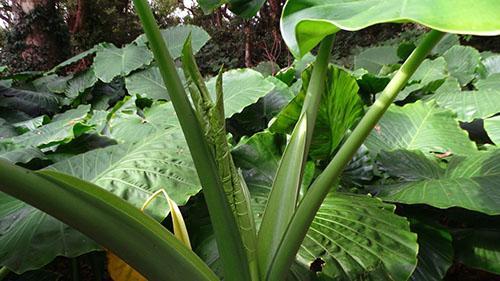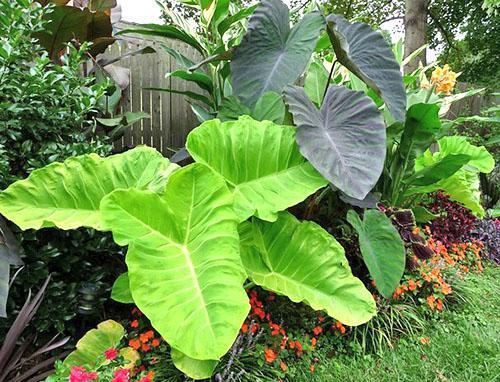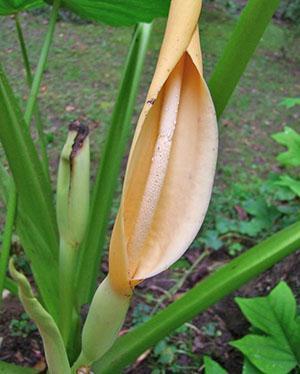An interesting story about the unique plant of the humid tropics alocasia
 Indoor plant lovers interested in alocasia can face an unexpected problem. The fact is that it will be very difficult to choose a suitable specimen, because alocasia is not one plant, but a huge genus, uniting almost eighty independent species.
Indoor plant lovers interested in alocasia can face an unexpected problem. The fact is that it will be very difficult to choose a suitable specimen, because alocasia is not one plant, but a huge genus, uniting almost eighty independent species.
Features and characteristics of alocasia

It is the foliage, thanks to which alocasia is compared to African masks, spearheads, serrated swords, elephant ears, and even dragon skin, that is of primary interest to indoor plant lovers.
How does alocasia bloom?
 If, however, an expert on plants of the aroid family is asked how alocasia bloom, it turns out that in most species the inflorescences are completely nondescript.
If, however, an expert on plants of the aroid family is asked how alocasia bloom, it turns out that in most species the inflorescences are completely nondescript.
In the warm season, when alocasia begins a period of active growth, peduncles appear from the leaf axils, which at first are easy to confuse with a new leaf. But only the peduncle begins to unfold and lengthen, it becomes clear that at its end there is an inflorescence in the form of an ear, wrapped in a dense perianth.
Both male and female flowers are located on one ear. Depending on the species and variety, both inflorescences and bedspreads vary in color and size.
Most often, alocasia plants form white or yellowish cobs, and the perianths are colored in different shades of green. Flowers of alocasia almost do not smell, with the exception of alocasia Odora or odorous, whose aroma resembles the scent of a lily.
The general characteristics of alocasia of different types include both the appearance and structure of the fruits. The orange or red berries are very small and even the largest specimens do not exceed 1 centimeter in diameter. Under a thin peel in the juicy pulp, there are several light, rounded seeds.
 However, such seeds are not always suitable for reproduction of alocasia plants.
However, such seeds are not always suitable for reproduction of alocasia plants.
The fact is that alocasia plants grown on window sills and in greenhouses are often complex or interspecific hybrids, and their seeds are completely sterile or do not retain the properties of the parent plant. Therefore, when breeding people from the distant tropics, it is easier to use vegetative methods, for example, root layers, parts of the stem and daughter tubers.
 Tuberous rhizomes of this amazing plant can be found not only in flower shops, but also in supermarkets in the south of China, in Japan, Singapore and other countries where alocasia grows.
Tuberous rhizomes of this amazing plant can be found not only in flower shops, but also in supermarkets in the south of China, in Japan, Singapore and other countries where alocasia grows.
Alocasia tubers - gourmet delicacy
 Although all parts of alocasia plants contain calcium oxalate, which is toxic to humans, the tubers and thick stems of certain species are widely used for food. Such varieties include large-rooted or Indian alocasia, which is widespread in the subtropical and tropical zone of Asia, in particular in India, the Philippines and Vietnam.
Although all parts of alocasia plants contain calcium oxalate, which is toxic to humans, the tubers and thick stems of certain species are widely used for food. Such varieties include large-rooted or Indian alocasia, which is widespread in the subtropical and tropical zone of Asia, in particular in India, the Philippines and Vietnam.
If the pulp of the tuber or the greens of the alocasia plant gets on the mucous membranes and skin of a person in its raw form, there is a strong burning sensation, pain. Breathing becomes difficult, pain and cramps make it difficult to swallow.
But even such risks do not stop the local population from preparing nutritious dishes from the roots of giant taro, as large types of alocasia are called. Alocasia tubers, sometimes weighing 400-600 grams, are rich in sugars, starchy substances and vitamins. It is a good source of carbohydrates, fiber, and minerals. You can only taste the sweetish, nutty taste of taro after a long heat treatment.
Today, alocasia tubers are a valuable dietary product from which flour is made, adding it to traditional baked goods, pastries, drinks and even ice cream.
 In the homeland of alocasia, you can taste stewed and fried tubers, which are used to make soups and desserts.
In the homeland of alocasia, you can taste stewed and fried tubers, which are used to make soups and desserts.
 You can make exotic chips at home. To do this, peeled tubers cut into thin slices are sprinkled with vegetable oil, slightly salted and sent to the oven for 20 minutes. At 180-200 ° C, the slices bake well and become crispy.
You can make exotic chips at home. To do this, peeled tubers cut into thin slices are sprinkled with vegetable oil, slightly salted and sent to the oven for 20 minutes. At 180-200 ° C, the slices bake well and become crispy.
When processing and cleaning the tubers of alocasia, one should not forget about possible damage to the skin, therefore, hands are pre-lubricated with vegetable oil or work with gloves.
 The popularity of tubers among gourmets has led to the fact that in their homeland alocasia plants are cultivated as an agricultural crop.
The popularity of tubers among gourmets has led to the fact that in their homeland alocasia plants are cultivated as an agricultural crop.
Alocasia hybrid plants for the passionate florist
 Alocasia is not only a source of valuable food raw materials, but also popular indoor plants. And here an important role is played by actively carried out breeding work, allowing flower growers to grow varieties and hybrids unseen in the wild.
Alocasia is not only a source of valuable food raw materials, but also popular indoor plants. And here an important role is played by actively carried out breeding work, allowing flower growers to grow varieties and hybrids unseen in the wild.
This success is evidenced by such an interesting fact about alocasia as the award of a special award from the Royal Horticultural Society of Great Britain to the creators of the famous alocasia Amazonica, which is an interspecific hybrid.
Over the decades that have passed since the middle of the last century, breeders have made significant progress, and alocasia plants have appeared at the disposal of flower growers, combining signs of seemingly dissimilar varieties and species.
 Exclusively thanks to the efforts of scientists, flower growers have obtained a hybrid species Alocasia cupredora, derived from crossing the plants of alocasia odora and Alocasia cuprea. The hybrid, called the "Dark Purple Shield" or "Maroon shield", retained the color of the foliage inherent in copper alocasia, but the size and structure of the plant more closely resemble the odora species.
Exclusively thanks to the efforts of scientists, flower growers have obtained a hybrid species Alocasia cupredora, derived from crossing the plants of alocasia odora and Alocasia cuprea. The hybrid, called the "Dark Purple Shield" or "Maroon shield", retained the color of the foliage inherent in copper alocasia, but the size and structure of the plant more closely resemble the odora species.
Plants of alocasia portora are well known to growers under the commercial name portodora. A hybrid species obtained from crossing Alocasia odora and Alocasia portei.
 Moreover, besides amazingly beautiful green plants, breeders managed to grow specimens with maroon veins and leaf stalks.
Moreover, besides amazingly beautiful green plants, breeders managed to grow specimens with maroon veins and leaf stalks.
 Sufficiently graceful plants of alocasia variety "Giant Zebra" are obtained from the parental pair Alocasia macrorrhizos and Alocasia zebrine. At the same time, for crossing, the breeders took the largest of the existing varieties of Indian alocasia. This is alocasia Borneo Giant, whose leaves are more than 120 cm long.
Sufficiently graceful plants of alocasia variety "Giant Zebra" are obtained from the parental pair Alocasia macrorrhizos and Alocasia zebrine. At the same time, for crossing, the breeders took the largest of the existing varieties of Indian alocasia. This is alocasia Borneo Giant, whose leaves are more than 120 cm long.
In Borneo, where the alocasia of this giant variety grows, plants are a tourist attraction and attract many tourists around them.
From the parental pair, the new plant of alocasia variety "Giant Zebra" got variegated petioles with a slightly blurred dark pattern and pointed leaves, like those of alocasia zebrin. In general, the variety is quite large and looks great in spacious rooms and greenhouses.
 While quite large species and varieties were described above, there is a great interest in miniature alocasia suitable for growing at home on the part of flower growers.
While quite large species and varieties were described above, there is a great interest in miniature alocasia suitable for growing at home on the part of flower growers.
The uniqueness of alocasia microdora plants is that it is the smallest specimen in the world. A Guinness World Record-worthy hybrid cannot yet be found in flower shops, but scientists hope the species will soon stabilize and become commercial.
 Alocasia sanderidora is a cross between the plants of alocasia Sanderiana "Nobilis" and alocasia scent.Descendants of known species have retained the arrow-shaped foliage, but its color has become softer. The petioles have acquired a brownish tint, and the size, in comparison with alocasia odora, decreased markedly.
Alocasia sanderidora is a cross between the plants of alocasia Sanderiana "Nobilis" and alocasia scent.Descendants of known species have retained the arrow-shaped foliage, but its color has become softer. The petioles have acquired a brownish tint, and the size, in comparison with alocasia odora, decreased markedly.
 Shown in the photo, morocco alocasia has already become available to flower growers and takes worthy places in home collections. This alocasia grows best in warm humid air. The culture requires a small winter dormant period, when the plant is almost not watered and kept in the dark. In summer, you can't do without frequent watering, light and nutrition.
Shown in the photo, morocco alocasia has already become available to flower growers and takes worthy places in home collections. This alocasia grows best in warm humid air. The culture requires a small winter dormant period, when the plant is almost not watered and kept in the dark. In summer, you can't do without frequent watering, light and nutrition.
 The showy plants of the Purple Cloak or Purple Cloak alocasia princeps are distinguished by dark triangular leaves with a purple back and a slightly wavy edge.
The showy plants of the Purple Cloak or Purple Cloak alocasia princeps are distinguished by dark triangular leaves with a purple back and a slightly wavy edge.
The height of the plant is 50–80 cm. Therefore, in the room where the alocasia of this species grows, the plant is looking for an illuminated, but protected from hot rays, worthy place.
The alocasia plants, named after the famous culture enthusiast and creator of many hybrid species, Brian Ulyams, are derived from a cross between Alocasia macrorrhiza and Alocasia Amazonica. Hybrid alocasia Williams Hybrid is quite cold-resistant, hardy and strong. She will find a place both in spacious rooms and in a greenhouse conservatory.
 Leaves in the shape of an African mask are dark green in color, wavy edges and light, prominent veins. The back of the new hybrid retained its lilac hue, but the plant is larger than that of the Amazonian alocasia.
Leaves in the shape of an African mask are dark green in color, wavy edges and light, prominent veins. The back of the new hybrid retained its lilac hue, but the plant is larger than that of the Amazonian alocasia.
 It is alocasia infernalis of the "Kapit" variety, recognized as the darkest of its kind in indoor plants. The foliage of the plant is thyroid and metallic gloss resembles the species cuprea and clypeolata, but is distinguished by a thick purplish-black hue, which persists in some of the petioles.
It is alocasia infernalis of the "Kapit" variety, recognized as the darkest of its kind in indoor plants. The foliage of the plant is thyroid and metallic gloss resembles the species cuprea and clypeolata, but is distinguished by a thick purplish-black hue, which persists in some of the petioles.
Many small alocasia species, like this Kapit plant, prefer a loose structured soil to which perlite or crushed bark can be added.
 Alokazia Maharani Variegata is the pearl of any collection of tropical plants! not only is the foliage of this species very thick, structured and has an unusual leathery texture, the breeders managed to fix a mutation that led to light spots on alocasia plants.
Alokazia Maharani Variegata is the pearl of any collection of tropical plants! not only is the foliage of this species very thick, structured and has an unusual leathery texture, the breeders managed to fix a mutation that led to light spots on alocasia plants.
The leaves of this alocasia plant are most reminiscent of stingrays, which is why the variety was named "Stingray". A natural mutation that appeared in nature was noticed and fixed by breeders. As a result, the growers got a unique variety with tailed green leaves, effectively collected along the central vein.
 Wherever alocasia grow, in the wild or in a city apartment, these plants need a lot of moisture, heat and dim, but long-term lighting. In their homeland, alocasia plants often settle along the banks of reservoirs, in humid lowlands and on chalk slopes, where streams of water flow down after rains.
Wherever alocasia grow, in the wild or in a city apartment, these plants need a lot of moisture, heat and dim, but long-term lighting. In their homeland, alocasia plants often settle along the banks of reservoirs, in humid lowlands and on chalk slopes, where streams of water flow down after rains.
At the same time, do not forget that moisture stagnation is detrimental to the roots, and only by maintaining balance and competently caring for a tropical inhabitant, you can admire the health and beauty of the alocasia plant for a long time.